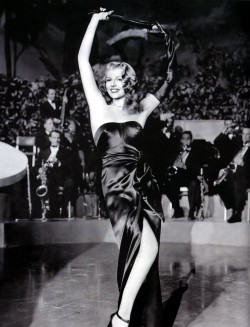Cinema | November 16th, 2016

The subgenre of crime thrillers known as “film noir” was at its height during the 1940s and 1950s. It is noted for cynical anti-heroic characters, a pervasive sense of inexorable fate, usually leading to the doom of one or more characters, and moody low-key cinematography featuring plenty of shadows with expressionistic lighting and camera angles.
Often there is a strong female character, frequently an aggressive “femme fatale,” and as often as not a seething sexual subtext that may or may not be easy to recognize due to the Hollywood Production Code restrictions on movie content at that time.
Film noir has had a minor renaissance in “neo-noir” and noir-influenced thrillers over the past thirty years but the modern films only on rare occasion achieve the satisfying blend of stylish visual artistry, narrative craftsmanship, and underlying social/psychological commentary that can be found during the mid-20th-century noir cycle. More and more noir films from the classic era are showing up on beautifully-restored Blu-rays as more film buffs rediscover the genre and voraciously seek out more examples to watch in high-quality editions that showcase their distinctive (usually black-and-white) imagery to best advantage. Here are three notable titles released over the last ten months.
“Gilda” (1946) has a reputation as one of the essential noir films, along with “Double Indemnity” (1944), “Out of the Past” (1947), “The Big Sleep” (1946), “Murder My Sweet” (1944), and others.
Glenn Ford stars as Johnny Farrell, a small-time gambler stuck in Buenos Aires. One night an eccentric casino owner named Ballin Mundsen (George Macready) rescues him from a back-alley murder attempt and hires him to manage his casino while he pursues various other shady interests. Then he returns from a trip married to glamorous singer Gilda (Rita Hayworth), not realizing that she and Johnny had previously been lovers and now hate each other.
The sudden appearance of Gilda puts an uncomfortable strain on Johnny and Ballin’s partnership/friendship, especially when Gilda flirts with rekindling her relationship with Johnny. Hayworth and Ford play wonderfully off each other and the odd but interesting dynamic between Ford and Macready hints at a deeper relationship than simple friendship. The homoerotic subtext is only moderately disguised.
As usual for a noir film, various subterfuges and double-crosses develop, and Hayworth also gets to belt out a couple of great song numbers.
Picture and sound quality on Criterion’s Blu-ray are excellent, and there’s a great set of bonus features, including a leaflet, commentary, two different discussions of the film, a trailer, and a vintage documentary on Hayworth’s career.
GILDA on Blu-ray -- Movie: A / Video: A / Audio: A / Extras: A-
“Road House” (1948), not to be confused with the mediocre 1989 action film starring Patrick Swayze, is a modestly-budgeted romantic melodrama that gradually evolves into a classic noir. It bears a number of similarities to “Gilda,” with a small-town lodge/nightclub/bowling alley near the Canadian border owned by eccentric and less-than-stable immature playboy Jefferson T. “Jefty” Robbins (Richard Widmark), who has his more business-like childhood friend Pete (Cornel Wilde) manage it.
Jefty returns from a trip to Chicago with sultry smoky-voiced singer Lily Stevens (Ida Lupino), hoping to marry her against the advice of the resentful Pete. She doesn’t care for either of them and feistily asserts that she’s just there to do a job, defying Pete’s attempt to send her back to Chicago. Although Pete can’t stand her at first, she doesn’t take long to seduce him, leading to nasty arguments and conflicts with Jefty, a robbery frame-up, a courtroom trial, and eventually a north woods shoot-out.
Some critics have theorized a homosexual backstory between Jefty and Pete, while others dismiss the idea and others never even consider it. Lupino’s costumes and aggressive sensuality gave censors enough to worry about, besides the metaphoric bowling sequences.
Kino’s Blu-ray has beautiful picture quality and good sound. Bonus features include a fun commentary by two noir historians, an interesting documentary on Widmark and Lupino, and a gallery of photos and promotional material. There are also trailers to three other noir films available from Kino.
ROAD HOUSE on Blu-ray -- Movie: A- / Video: A / Audio: A / Extras: B
“Appointment With Crime” (1946) is a British take on crime melodrama, obviously influenced by American noir, and lacking a few of the restrictions imposed by Hollywood’s self-censorship regulations.
Some gangsters persuade small-time crook Leo Martin (William Hartnell, who would later play “Dr. Who”) to pull a risky daylight heist, but he’s caught and sent to prison. Once he gets out, he naturally decides to take revenge on the men who set him up and refused to help him, soon becoming much nastier than the anti-heroes in most American noirs.
Along the way he meets an attractive dancehall girl (Joyce Howard) he’d like to settle down with, but becomes so obsessed with revenge that he goes after the crime bosses who originally ordered the heist responsible for his prison term.
Interestingly there is no attempt to disguise the homosexual relationship between the cultured crime boss (Herbert Lom) and his more effeminate associate. This aspect as well as a substantial use of “hell” and “damn” were very likely censored for the American release five years later. Venerable character actor Wilfrid Hyde-White has a bit part as a beer-loving janitor at the dancehall.
Olive Films’ Blu-ray has very good picture quality, although a bit low in contrast and slightly soft at the start. Audio isn’t bad but dialogue is sometimes muddled due to the heavy British accents. There are no extras beyond a chapter menu and optional English subtitles that frequently don’t match the dialogue.
APPOINTMENT WITH CRIME on Blu-ray -- Movie: A- / Video: A- / Audio: A- / Extras: F
January 5th 2026
December 29th 2025
December 29th 2025
December 16th 2025
December 9th 2025
__293px-wide.jpg)



_(1)__293px-wide.png)
_(1)__293px-wide.jpg)